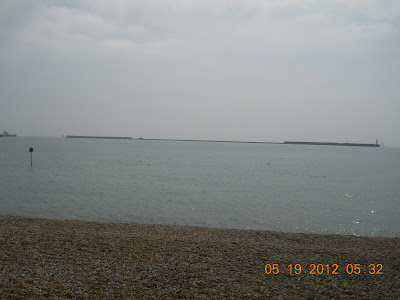Place(s) visited: Canterbury and Dover, England
Morning beauty before train ride to Canterbury and Dover, England
Dover, England Today
Originally established in 1606, Dover Harbour Board is responsible for the administration, maintenance and improvement of the harbour at Dover.
It operates right at the heart of the UK's and Continental Europe's cross-Channel transport network, managing and piloting what has become one of today's busiest drive-on, drive-off terminals in the world.
Canterbury is world-famous, primarily because of Chaucer's Canterbury Tales, but its roots go back much further than that. The Canterbury Tales were written seven hundred years ago, in the late 1300's - by then, Archbishop Thomas Becket's murder (which led to the pilgrimages immortalised by Chaucer) was already 200 years in the past. By Chaucer's time there had been settlement in Canterbury for over 1,300 years!
The History Of Canterbury Cathedral
Canterbury Cathedral is alive with history and many fascinating stories. The information below gives a brief insight into the history of this magnificent building.
The Origins of Canterbury Cathedral
St Augustine, the first Archbishop of Canterbury, arrived on the coast of Kent as a missionary to England in 597 AD. He came from Rome, sent by Pope Gregory the Great. It is said that Gregory had been struck by the beauty of Angle slaves he saw for sale in the city market and despatched Augustine and some monks to convert them to Christianity.
Augustine was given a church at Canterbury (St Martin's, after St Martin of Tours, still standing today) by the local King, Ethelbert whose Queen, Bertha, a French Princess,, was already a Christian. This building had been a place of worship during the Roman occupation of Britain and is the oldest church in England still in use.
Augustine had been consecrated a bishop in France and was later made an archbishop by the Pope. He established his seat within the Roman city walls (the Latin word for a seat is cathedra, from which the word cathedral is derived) and built the first cathedral there, becoming the first Archbishop of Canterbury. Since that time, there has been a community around the Cathedral offering daily prayer to God; this community is arguably the oldest organisation in the English speaking world. The present Archbishop, The Most Revd and Right Honourable Dr Rowan Williams, is 104th in the line of succession from Augustine.
 Until the 10th century the Cathedral community lived as the household of the Archbishop. During the 10th century, it became a formal community of Benedictine monks, which continued until the monastery was dissolved by King Henry VIII in 1540.
Until the 10th century the Cathedral community lived as the household of the Archbishop. During the 10th century, it became a formal community of Benedictine monks, which continued until the monastery was dissolved by King Henry VIII in 1540.
Augustine's original building lies beneath the floor of the nave– it was extensively rebuilt and enlarged by the Saxons, and the Cathedral was rebuilt completely by the Normans in 1070 following a major fire. There have been many additions to the building over the last nine hundred years, but parts of the quire and some of the windows and their stained glass date from the 12th century.
By 1077, Archbishop Lanfranc had rebuilt it as a Norman church, described as "nearly perfect". A staircase and parts of the North Wall - in the area of the North West transept also called the Martyrdom - remain from that building.
It was a beautiful day in Canterbury and Dover. We were all very happy we got to relax at the beach and walk the reach of the place where the birth of The Canterbury Tales was originated. All of us also learned quite a bit about the history of Canterbury and Dover and its significance to its prospective town.
Thank you for checking back! :)
Stay tuned for more updates! :D
~Lucky :) <3



























































No comments:
Post a Comment
Thank you for your comment! I love your enthusiasm for this trip and I appreciate your understanding of the fact that if your comment does not appear immediately it is due to the fact that I have not gotten to it to approve it yet, this is for security reasons. Thanks! :)